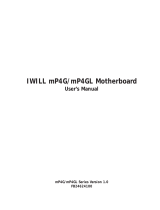
P4D/P4D-N Motherboard
User’s Manual
VI
LAN Port (Optional by Model) ..................................................... 2.17
Parallel Port ............................................................................ 2.17
Serial (COM) Ports .................................................................... 2.18
Audio Jacks & Connectors .......................................................... 2.18
Jumpers ..................................................................................... 2.19
JP1 Clear CMOS ........................................................................ 2.19
JP6 Keyboard Power On ............................................................. 2.19
JP10 Audio Chip ...................................................................... 2.19
JP16 Flash Protect ................................................................... 2.19
JP17 LAN Chip ......................................................................... 2.19
Software Features.......................................................................... 2.20
Using the Power Installer Disc ....................................................... 2.20
Driver Software ........................................................................... 2.21
Utility Software ........................................................................... 2.22
3: Motherboard Configuration ............................................... 3.1
The Default Configuration................................................................ 3.1
Hardware Configuration: Jumper Settings ..........................................3.1
Jumper JP6: Clear CMOS Memory ...................................................3.2
Jumper JP4: BIOS Flash Protect ....................................................3.4
Jumper JP6: Keyboard Power On ...................................................3.6
Jumper JP10: Audio Chip.............................................................3.6
Jumper JP17: LAN Chip ...............................................................3.6
Firmware Configuration: The CMOS Setup Utility .................................3.7
Using the CMOS Setup Utility........................................................3.7
Reconfiguring the Motherboard ........................................................ 3.9
Hardware Reconfiguration ...............................................................3.9
Firmware Reconfiguration ...............................................................3.9
4: Installing the Motherboard ............................................... 4.1
Pre-installation Preparation............................................................. 4.1
Installing A CPU ............................................................................4.2
Processor Selection .....................................................................4.2
Installing The Processor...............................................................4.3
Installing the Heatsink................................................................4.5
Installing System Memory ...............................................................4.8
Memory Specifications .................................................................4.8
Memory Configuration Options ...................................................... 4.8
Installing Memory Modules........................................................... 4.9
System Memory Recognition ....................................................... 4.10
Installing the Motherboard in a System Housing ............................... 4.10























